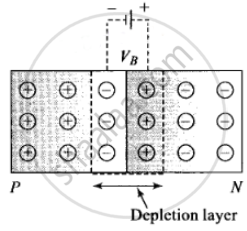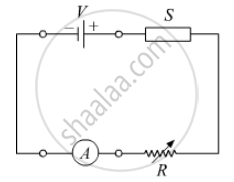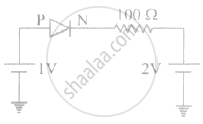Advertisements
Advertisements
प्रश्न
In the depletion region of a diode ______.
- there are no mobile charges.
- equal number of holes and electrons exist, making the region neutral.
- recombination of holes and electrons has taken place.
- immobile charged ions exist.
पर्याय
a and b
a, b and d
c and d
a, b, c and d
उत्तर
a, b, c and d
Explanation:
On account of the difference in concentration of charge carrier in the two sections of the P-N junction, the electrons from N-region diffuse through the junction into P-region and the hole from P-region diffuse into N-region.

Due to diffusion, the neutrality of both N and P-type semiconductor is disturbed, a layer of negatively charged ions appear near the junction in the P-crystal and a layer of positive ions appears near the junction in N-crystal. This layer is called the depletion layer.
The thickness of the depletion layer is 1 micron = 10-6 m.
Width of depletion layer ∞ 1/Dopping
Depletion is directly proportional to temperature.
Important point: The P-N junction diode is equivalent to the capacitor in which the depletion layer acts as a dielectric.
APPEARS IN
संबंधित प्रश्न
In the following diagram 'S' is a semiconductor. Would you increase or decrease the value of R to keep the reading of the ammeter A constant when S is heated? Give reason for your answer.

Show on a graph, the variation of resistivity with temperature for a typical semiconductor.
A triode value operates at Vp = 225 V and Vg = −0.5 V.
The plate current remains unchanged if the plate voltage is increased to 250 V and the grid voltage is decreased to −2.5 V. Calculate the amplification factor.
The dynamic plate resistance of a triode value is 10 kΩ. Find the change in the plate current if the plate voltage is changed from 200 V to 220 V.
Answer the following question.
Why photodiodes are required to operate in reverse bias? Explain.
The current through an ideal PN-junction shown in the following circuit diagram will be:

The drift current in a p-n junction is from the ______.
The nature of binding for a crystal with alternate and evenly spaced positive and negatively ions is
In the circuit shown in figure, if the diode forward voltage drop is 0.3 V, the voltage difference between A and B is ______.

Draw the circuit arrangement for studying V-I characteristics of a p-n junction diode in (i) forward biasing and (ii) reverse biasing. Draw the typical V-I characteristics of a silicon diode.
